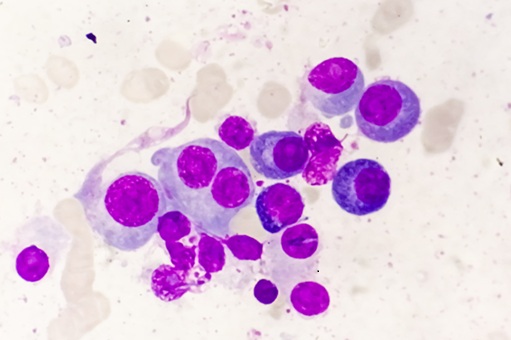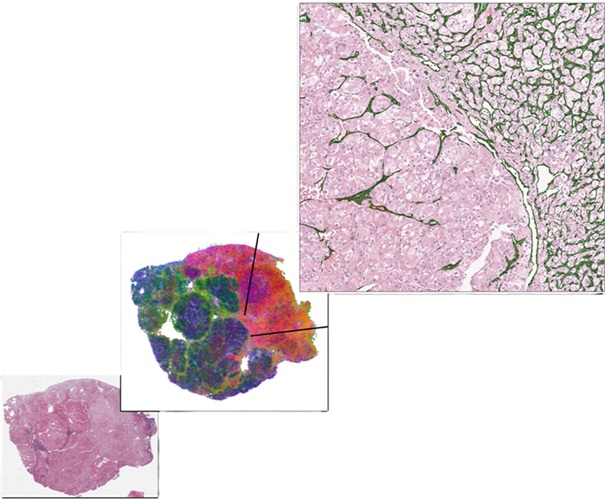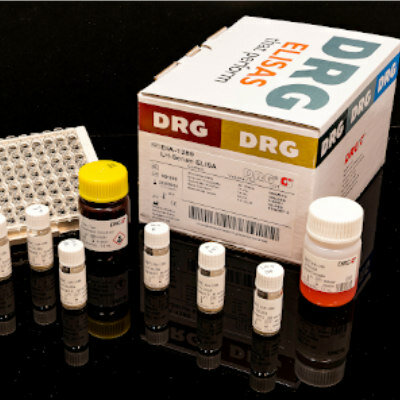RBC Distribution Width Associated with COVID-19 Mortality Risk
|
By LabMedica International staff writers Posted on 06 Oct 2020 |

Image: Scanning electron microscope image shows SARS-CoV-2 (yellow) the virus that causes COVID-19, isolated from a patient in the USA, emerging from the surface of cells (pink) cultured in the laboratory (Photo courtesy of NIAID-RML).
COVID-19 has a high rate of hospitalization, critical care requirement, and mortality. Identifying patients at highest risk for severe disease is important to facilitate early, aggressive intervention and to manage local hospital resources to mitigate the critical care crises that have impacted some hospital systems.
The red blood cell distribution width (RDW) is a standard component of a routine complete blood count test. Elevated RDW is associated with an increased risk for all-cause mortality; mortality from heart disease, pulmonary disease, sepsis, influenza, and cancer; complications associated with heart failure, severity of coronary artery disease and viral hepatitis, advanced stage and grade for many cancers.
A team of Medical Scientists at the Massachusetts General Hospital (Boston, MA, USA) retrospectively analyzed for 1,641 patients’ data who tested positive for SARS-CoV-2 infection between March 4, 2020, and April 28, 2020. Participants in the study had a mean age of 62 years, 54% were men, 45% were White individuals and 30% Hispanic, and 17% of patients in the cohort died.
For all inpatients, RDW, absolute lymphocyte count, and D-dimer level were collected approximately daily along with other clinical laboratory values, as part of standard clinical care. Complete blood counts, including RDW and lymphocyte count were performed on an XN-9000 Automated Hematology System (Sysmex Corporation, Kobe, Japan). D-dimer level was measured using a Vidas 3 immunoanalyzer (bioMérieux, Marcy-l'Étoile, France).
The team reported that patients whose RDW was greater than 14.5% at admission for a COVID-19 diagnosis had a mortality risk of 31%, whereas those with an RDW of 14.5% or less had a mortality risk of 11%. The relative risk (RR) of mortality for those with an elevated RDW was 2.73. In patient groups stratified by age, elevated RDW remained associated with increased RR of mortality for patients younger than 50 years, 50 to 59 years, 60 to 69 years, and 80 years or older. The study found that patients with elevated RDW at admission were 6.12 times more likely to die within 48 hours, 23/470 (4.9%) patients than patients with a normal RDW, 9/1175 (0.8%) patients.
An increasing RDW during hospitalization was linked to a greater risk of death than if RDW did not change. The mortality risk jumped from 6% to 24% for those with a normal RDW at admission, and from 22% to 40% for those with an elevated RDW when they were admitted. The association was also independent of D-dimer levels, absolute lymphocyte count, demographic factors, and common comorbidities
The authors concluded that in this cohort study of patients hospitalized for COVID-19, RDW measured at admission and during hospitalization was associated with a statistically significant increase in mortality. RDW is a routine laboratory test that may be useful in risk stratification of hospitalized patients with COVID-19. The study was published on September 23, 2020 in the journal JAMA Network Open.
Related Links:
Massachusetts General Hospital
Sysmex Corporation
bioMérieux
The red blood cell distribution width (RDW) is a standard component of a routine complete blood count test. Elevated RDW is associated with an increased risk for all-cause mortality; mortality from heart disease, pulmonary disease, sepsis, influenza, and cancer; complications associated with heart failure, severity of coronary artery disease and viral hepatitis, advanced stage and grade for many cancers.
A team of Medical Scientists at the Massachusetts General Hospital (Boston, MA, USA) retrospectively analyzed for 1,641 patients’ data who tested positive for SARS-CoV-2 infection between March 4, 2020, and April 28, 2020. Participants in the study had a mean age of 62 years, 54% were men, 45% were White individuals and 30% Hispanic, and 17% of patients in the cohort died.
For all inpatients, RDW, absolute lymphocyte count, and D-dimer level were collected approximately daily along with other clinical laboratory values, as part of standard clinical care. Complete blood counts, including RDW and lymphocyte count were performed on an XN-9000 Automated Hematology System (Sysmex Corporation, Kobe, Japan). D-dimer level was measured using a Vidas 3 immunoanalyzer (bioMérieux, Marcy-l'Étoile, France).
The team reported that patients whose RDW was greater than 14.5% at admission for a COVID-19 diagnosis had a mortality risk of 31%, whereas those with an RDW of 14.5% or less had a mortality risk of 11%. The relative risk (RR) of mortality for those with an elevated RDW was 2.73. In patient groups stratified by age, elevated RDW remained associated with increased RR of mortality for patients younger than 50 years, 50 to 59 years, 60 to 69 years, and 80 years or older. The study found that patients with elevated RDW at admission were 6.12 times more likely to die within 48 hours, 23/470 (4.9%) patients than patients with a normal RDW, 9/1175 (0.8%) patients.
An increasing RDW during hospitalization was linked to a greater risk of death than if RDW did not change. The mortality risk jumped from 6% to 24% for those with a normal RDW at admission, and from 22% to 40% for those with an elevated RDW when they were admitted. The association was also independent of D-dimer levels, absolute lymphocyte count, demographic factors, and common comorbidities
The authors concluded that in this cohort study of patients hospitalized for COVID-19, RDW measured at admission and during hospitalization was associated with a statistically significant increase in mortality. RDW is a routine laboratory test that may be useful in risk stratification of hospitalized patients with COVID-19. The study was published on September 23, 2020 in the journal JAMA Network Open.
Related Links:
Massachusetts General Hospital
Sysmex Corporation
bioMérieux
Latest Hematology News
- New Scoring System Predicts Risk of Developing Cancer from Common Blood Disorder
- Non-Invasive Prenatal Test for Fetal RhD Status Demonstrates 100% Accuracy
- WBC Count Could Predict Severity of COVID-19 Symptoms
- New Platelet Counting Technology to Help Labs Prevent Diagnosis Errors
- Streamlined Approach to Testing for Heparin-Induced Thrombocytopenia Improves Diagnostic Accuracy
- POC Hemostasis System Could Help Prevent Maternal Deaths
- New Test Assesses Oxygen Delivering Ability of Red Blood Cells by Measuring Their Shape
- Personalized CBC Testing Could Help Diagnose Early-Stage Diseases in Healthy Individuals
- Non-Invasive Test Solution Determines Fetal RhD Status from Maternal Plasma
- First-Of-Its-Kind Smartphone Technology Noninvasively Measures Blood Hemoglobin Levels at POC

- Next Gen CBC and Sepsis Diagnostic System Targets Faster, Earlier, Easier Results
- Newly Discovered Blood Group System to Help Identify and Treat Rare Patients
- Blood Platelet Score Detects Previously Unmeasured Risk of Heart Attack and Stroke
- Automated Benchtop System to Bring Blood Testing To Anyone, Anywhere
- New Hematology Analyzers Deliver Combined ESR and CBC/DIFF Results in 60 Seconds
- Next Generation Instrument Screens for Hemoglobin Disorders in Newborns
Channels
Clinical Chemistry
view channel
Mass Spectrometry-Based Monitoring Technique to Predict and Identify Early Myeloma Relapse
Myeloma, a type of cancer that affects the bone marrow, is currently incurable, though many patients can live for over 10 years after diagnosis. However, around 1 in 5 individuals with myeloma have a high-risk... Read more
‘Brilliantly Luminous’ Nanoscale Chemical Tool to Improve Disease Detection
Thousands of commercially available glowing molecules known as fluorophores are commonly used in medical imaging, disease detection, biomarker tagging, and chemical analysis. They are also integral in... Read more
Low-Cost Portable Screening Test to Transform Kidney Disease Detection
Millions of individuals suffer from kidney disease, which often remains undiagnosed until it has reached a critical stage. This silent epidemic not only diminishes the quality of life for those affected... Read more
New Method Uses Pulsed Infrared Light to Find Cancer's 'Fingerprints' In Blood Plasma
Cancer diagnoses have traditionally relied on invasive or time-consuming procedures like tissue biopsies. Now, new research published in ACS Central Science introduces a method that utilizes pulsed infrared... Read moreMolecular Diagnostics
view channel
Genetic-Based Tool Predicts Survival Outcomes of Pancreatic Cancer Patients
A tumor marker is a substance found in the body that may signal the presence of cancer. These substances, which can include proteins, genes, molecules, or other biological compounds, are either produced... Read more
Urine Test Diagnoses Early-Stage Prostate Cancer
Prostate cancer is one of the leading causes of death among men worldwide. A major challenge in diagnosing the disease is the absence of reliable biomarkers that can detect early-stage tumors.... Read moreImmunology
view channel
Stem Cell Test Predicts Treatment Outcome for Patients with Platinum-Resistant Ovarian Cancer
Epithelial ovarian cancer frequently responds to chemotherapy initially, but eventually, the tumor develops resistance to the therapy, leading to regrowth. This resistance is partially due to the activation... Read more
Machine Learning-Enabled Blood Test Predicts Immunotherapy Response in Lymphoma Patients
Chimeric antigen receptor (CAR) T-cell therapy has emerged as one of the most promising recent developments in the treatment of blood cancers. However, over half of non-Hodgkin lymphoma (NHL) patients... Read moreMicrobiology
view channel
New Test Diagnoses Bacterial Meningitis Quickly and Accurately
Bacterial meningitis is a potentially fatal condition, with one in six patients dying and half of the survivors experiencing lasting symptoms. Therefore, rapid diagnosis and treatment are critical.... Read more
Handheld Device Delivers Low-Cost TB Results in Less Than One Hour
Tuberculosis (TB) remains the deadliest infectious disease globally, affecting an estimated 10 million people annually. In 2021, about 4.2 million TB cases went undiagnosed or unreported, mainly due to... Read more
New AI-Based Method Improves Diagnosis of Drug-Resistant Infections
Drug-resistant infections, particularly those caused by deadly bacteria like tuberculosis and staphylococcus, are rapidly emerging as a global health emergency. These infections are more difficult to treat,... Read more
Breakthrough Diagnostic Technology Identifies Bacterial Infections with Almost 100% Accuracy within Three Hours
Rapid and precise identification of pathogenic microbes in patient samples is essential for the effective treatment of acute infectious diseases, such as sepsis. The fluorescence in situ hybridization... Read morePathology
view channel
AI-Based Model Predicts Kidney Cancer Therapy Response
Each year, nearly 435,000 individuals are diagnosed with clear cell renal cell carcinoma (ccRCC), making it the most prevalent subtype of kidney cancer. When the disease spreads, anti-angiogenic therapies... Read more
Sensitive and Specific DUB Enzyme Assay Kits Require Minimal Setup Without Substrate Preparation
Ubiquitination and deubiquitination are two important physiological processes in the ubiquitin-proteasome system, responsible for protein degradation in cells. Deubiquitinating (DUB) enzymes contain around... Read moreTechnology
view channel
Light Signature Algorithm to Enable Faster and More Precise Medical Diagnoses
Every material or molecule interacts with light in a unique way, creating a distinct pattern, much like a fingerprint. Optical spectroscopy, which involves shining a laser on a material and observing how... Read more
Disposable Microchip Technology Could Selectively Detect HIV in Whole Blood Samples
As of the end of 2023, approximately 40 million people globally were living with HIV, and around 630,000 individuals died from AIDS-related illnesses that same year. Despite a substantial decline in deaths... Read more
Pain-On-A-Chip Microfluidic Device Determines Types of Chronic Pain from Blood Samples
Chronic pain is a widespread condition that remains difficult to manage, and existing clinical methods for its treatment rely largely on self-reporting, which can be subjective and especially problematic... Read more
Innovative, Label-Free Ratiometric Fluorosensor Enables More Sensitive Viral RNA Detection
Viruses present a major global health risk, as demonstrated by recent pandemics, making early detection and identification essential for preventing new outbreaks. While traditional detection methods are... Read moreIndustry
view channel
Cepheid and Oxford Nanopore Technologies Partner on Advancing Automated Sequencing-Based Solutions
Cepheid (Sunnyvale, CA, USA), a leading molecular diagnostics company, and Oxford Nanopore Technologies (Oxford, UK), the company behind a new generation of sequencing-based molecular analysis technologies,... Read more
Grifols and Tecan’s IBL Collaborate on Advanced Biomarker Panels
Grifols (Barcelona, Spain), one of the world’s leading producers of plasma-derived medicines and innovative diagnostic solutions, is expanding its offer in clinical diagnostics through a strategic partnership... Read more

















